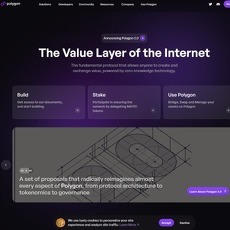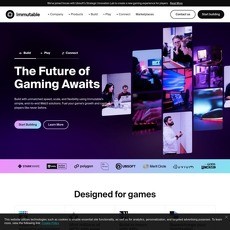Mantle Network Review
Mantle Network
mantle.xyz
Mantle Network Review: Scaling Ethereum with Security and Efficiency
Today, I'm thrilled to dive deep into Mantle Network, a technology stack that's making waves in the world of Ethereum scaling. In this article, we'll explore what Mantle Network is all about, its advantages over non-rollup chains, its modular architecture, and how it's revolutionizing data availability. So, buckle up, fellow crypto enthusiasts, as we embark on this journey into the world of Mantle Network!
Mantle Network: A Game Changer for Ethereum Scaling
Mantle Network is a breath of fresh air in the Ethereum ecosystem, and its primary mission is clear - to scale Ethereum while maintaining EVM (Ethereum Virtual Machine) compatibility. This compatibility ensures that all your favorite Ethereum contracts and tools work seamlessly on Mantle Network with minimal modifications. Whether you're an avid user of web3 apps or a developer looking to deploy smart contracts, Mantle Network offers an efficient, low-fee environment for you to thrive.
EVM Compatibility and More
At its core, Mantle Network boasts a modular architecture that combines an optimistic rollup protocol with an innovative data availability solution. This unique blend allows Mantle Network to inherit security from Ethereum while providing cheaper and more accessible data availability.
Now, if you're new to terms like "optimistic rollups" or "data availability," don't worry; we've got you covered. But for those who are already excited about the potential of blockchain scaling, keep reading to uncover the gems Mantle Network has to offer.
Mantle Network vs. Non-Rollup Chains
One of Mantle Network's standout features is its reliance on Ethereum's validator set and consensus protocol, widely acknowledged as one of the most secure in the industry. This reliance brings forth several advantages:
Canonical Bridging and Censorship Resistance
Mantle Network doesn't depend on third-party bridges for canonical bridging. This means you can enjoy seamless interoperability without worrying about the security of your assets. Additionally, the network offers censorship resistance, ensuring your transactions remain private and secure.
Fund Recovery and Security
In the unfortunate event of critical issues on Layer 2 (L2), Mantle Network has mechanisms in place for fund recovery. Your assets are protected, providing peace of mind even in the face of unforeseen challenges.
Secured by Ethereum
By building on top of Ethereum, Mantle Network inherits the best of both worlds. L2 state transitions are verified by Ethereum validators, going through the same consensus and settlement process as L1 transactions. This results in a robust and secure ecosystem.
Developer-Friendly Environment
For developers, Mantle Network offers a familiar environment. You can use popular smart contract development frameworks like Truffle, Hardhat, Foundry, Remix, and languages like Solidity, Vyper, Yul, along with libraries like Web3.js and ethers.js. This ensures a smooth transition to building on Mantle Network.
Lower Gas Fees and Improved Throughput
One of the most exciting benefits for users is the significant reduction in gas fees. With over an 80% reduction achieved through data compression and modular data availability, users can enjoy cost-effective transactions. Moreover, Mantle Network boasts reduced latency and improved throughput, with transaction confirmation times as low as 10 milliseconds and a transaction throughput 20 times greater than Ethereum's.
Modular Architecture: The Heart of Mantle Network
Mantle Network's approach to chain design is modular, setting it apart from monolithic chains. While traditional chains handle transaction execution, consensus, settlement, and storage all within the same network layer, Mantle Network takes a different route:
Three Key Modules
- Execution Layer: This layer provides an EVM-compatible environment for transaction execution. Here, the sequencer produces blocks on L2 and sends state root data to L1.
- Consensus and Settlement: These crucial processes occur on L1 Ethereum, ensuring the utmost security and decentralization.
- Data Availability Services: Network actors access data availability services through Mantle DA, powered by EigenDA technology. This technology stores callback data that would typically be published to L1 in traditional rollups.
Sequencer Properties
The centralized sequencer on Mantle Network plays a pivotal role. It produces L2 blocks by including transactions in the order they are received by the nodes. Additionally, Mantle Network includes an additional sequencer module called the Threshold Signature Scheme (TSS). This module consists of a set of whitelisted node operators who sign blocks, contributing to multi-party signatures that enhance the correctness of off-chain transaction execution results.
Fraud Proofs: Ensuring Data Integrity
In the world of Optimistic Rollups, transactions that result in state transitions are executed without providing direct proofs for their validity. Mantle Network addresses this challenge with a robust mechanism called Fraud Proofs.
State Commitment Chain
Mantle Network sends updated state data to a State Commitment Chain (SCC) contract on L1 Ethereum. Here, network actors can challenge the validity of state data within a specific challenge period (currently set to 7 days). If unchallenged, the state data is considered valid and final, enabling withdrawal requests relying on this data to be processed by other smart contracts.
Ensuring Validity
In case of a challenge, a verifier interacts with the challenger to narrow down the invalidity to a single state transition. Once the validity is established through execution, the contract accepts the valid version of the updated state submitted by the challenger. This mechanism ensures the integrity of data on Mantle Network.
Data Availability: A Cost-Efficient Approach
Data availability is a critical aspect of Ethereum rollups, as it enables L1 validators to verify the L2 state. Mantle Network takes a unique approach to this, known as Modular Data Availability.
Cost Savings
Traditional approaches include on-chain L1 data availability or centralized DA committees. However, Mantle DA, powered by EigenLayer's EigenDA technology, introduces a cost-efficient method. This approach involves rewards and stake slashing, resulting in a 30-70% cost savings compared to on-chain L1 solutions. This innovation significantly contributes to the affordability of Mantle Network.
Getting Started with Mantle Network
Excited to dive into the world of Mantle Network? Here's how you can get started:
- Explore Mantle Network's L2 rollup infrastructure, tailored to the growing $MNT ecosystem.
- Reach out to their growth team for support and guidance.
- Access essential information on linking your wallet to Mantle Network, acquiring testnet tokens, and exploring development tutorials in the Quick Start section.
FAQs: Your Burning Questions Answered
To wrap things up, let's address some frequently asked questions about Mantle Network:
General
Can I use Truffle, Hardhat, and Remix to deploy contracts on Mantle Network?
Absolutely! Mantle Network welcomes all EVM-compatible Web3 libraries, IDEs, and development frameworks. You can seamlessly deploy and connect to Mantle Network using popular tools like Remix, Truffle, Hardhat, Foundry, Web3.js, Ethers.js, and more.
What signature algorithm does Mantle Network use?
Mantle Network utilizes the same signature algorithm as Ethereum: ECDSA on the secp256k1 curve.
What's the block gas limit on Mantle Network?
Currently, the block gas limit stands at 30,000,000, or 30M units.
What's the average block time on Mantle Network?
The block time on Mantle Network depends on the transaction volume at any given time. New blocks are generated on L2 every time a new transaction is received, with each block containing a single transaction.
How does transaction finality work on Mantle Network?
Transaction and block finality on L2 is instantaneous, while on L1, it connects to the challenge period, currently set at 7 days.
Are fraud proofs online on Mantle Network?
As of the mainnet alpha release, fraud proofs are in development. For more details, check out the dedicated page on Fraud Proofs.
Data Availability
How does modular data availability bring down transaction costs?
Modular Data Availability, as implemented on Mantle Network, significantly reduces transaction costs. By posting only state root data to L1 contracts and utilizing Mantle DA for rollup data, Mantle Network achieves substantial cost savings, making transactions more affordable for users.
Can I fetch DA transaction details with an API?
Currently, the only way to access DA transaction history is through the Explorer frontend. Here's the link: Mantle Explorer.
Protocol
Do Rollup Verifier nodes verify every piece of block data processed by the Sequencer?
Yes, Rollup Verifier nodes diligently verify all updated state roots before submitting them to L1 as part of the rollup process, ensuring data integrity.
Do Rollup Verifiers sync rollup data from the Sequencer?
No, Rollup Verifiers sync rollup data from Mantle DA, which is used to generate state roots and verify the updated state roots produced by the Sequencer before they are published to L1.
Smart Contracts
Where can I find multicall contracts on Mantle Network?
You can find multicall contracts on Mantle Network at the following addresses:
- Testnet multicall address: 0xA70bD0f369C776B2774FD3C0949DCb5251fC3b79
- Mainnet multicall address: 0x9155FcC40E05616EBFf068446136308e757e43dA
Does Mantle Network support contract creation using CREATE2 and CREATE3?
Mantle Network currently supports CREATE2 and is actively working on supporting CREATE3 in a future update.
Transactions
What's the transaction lifecycle like on Mantle Network?
The transaction lifecycle on Mantle Network involves the initiation of a transaction, its execution by the sequencer, the signing of state roots by the TSS network to guarantee correctness, and the posting of state root data to L1 Ethereum and transaction data to Mantle DA. For a detailed description, check out the dedicated page on Transaction Lifecycle.
I noticed unknown gas fees being deducted from my wallet when sending transactions. Why is that?
Mantle Network's gas oracle API currently supports fetching L2 gas fees only. The additional fee deducted is the L1 rollup fee, and this issue will be addressed in a future update.
Are there any limits set for batch transaction size?
The maximum batch transaction size on Mantle Network is derived from the target gas configuration and is the same as Ethereum in this regard.
Are there any limits on the gas price that can be paid when sending transactions on Mantle Network?
To protect users from overpaying gas fees, the gas price range on Mantle Network is currently set at 0.05 - 200 Gwei. This limit is active on Mantle Mainnet and will soon be applied to the testnet as well.
Does Mantle Network support EIP-1559?
As of now, Mantle Network does not support EIP-1559. Transactions on Mantle Network follow a FIFO order based on the sequence they are received in.
Does Mantle Network support transactions that aren't signed with the chain ID?
No, Mantle Network does not support pre-EIP155 transactions that aren't signed with the chain ID.
Explorer
Does the RPC rate limit affect Explorer API usage too?
Yes, once the RPC rate limit is reached, access to the Explorer API will also be limited.
Node Operators
How big is the current testnet state?
For detailed information on the current testnet state's size, you can refer to this link.
In Conclusion
Mantle Network is undoubtedly making waves in the blockchain world by providing a scalable, secure, and developer-friendly ecosystem. With its EVM compatibility, modular architecture, and innovative solutions for data availability, it's poised to reshape the Ethereum landscape.
As the crypto world continues to evolve, Mantle Network stands as a testament to the boundless innovation happening within the industry. Whether you're a user looking for cost-effective transactions or a developer seeking a robust platform, Mantle Network has something exciting in store for you.
So, fellow crypto enthusiasts, keep an eye on Mantle Network as it continues to redefine the future of blockchain scaling, one block at a time.
Dive deeper into Mantle Network and other cutting-edge blockchain solutions at CryptoLinks.com, where you’ll find expert reviews, trusted resources, and the latest insights to fuel your crypto journey. Explore now and unlock the future of decentralized technology!








